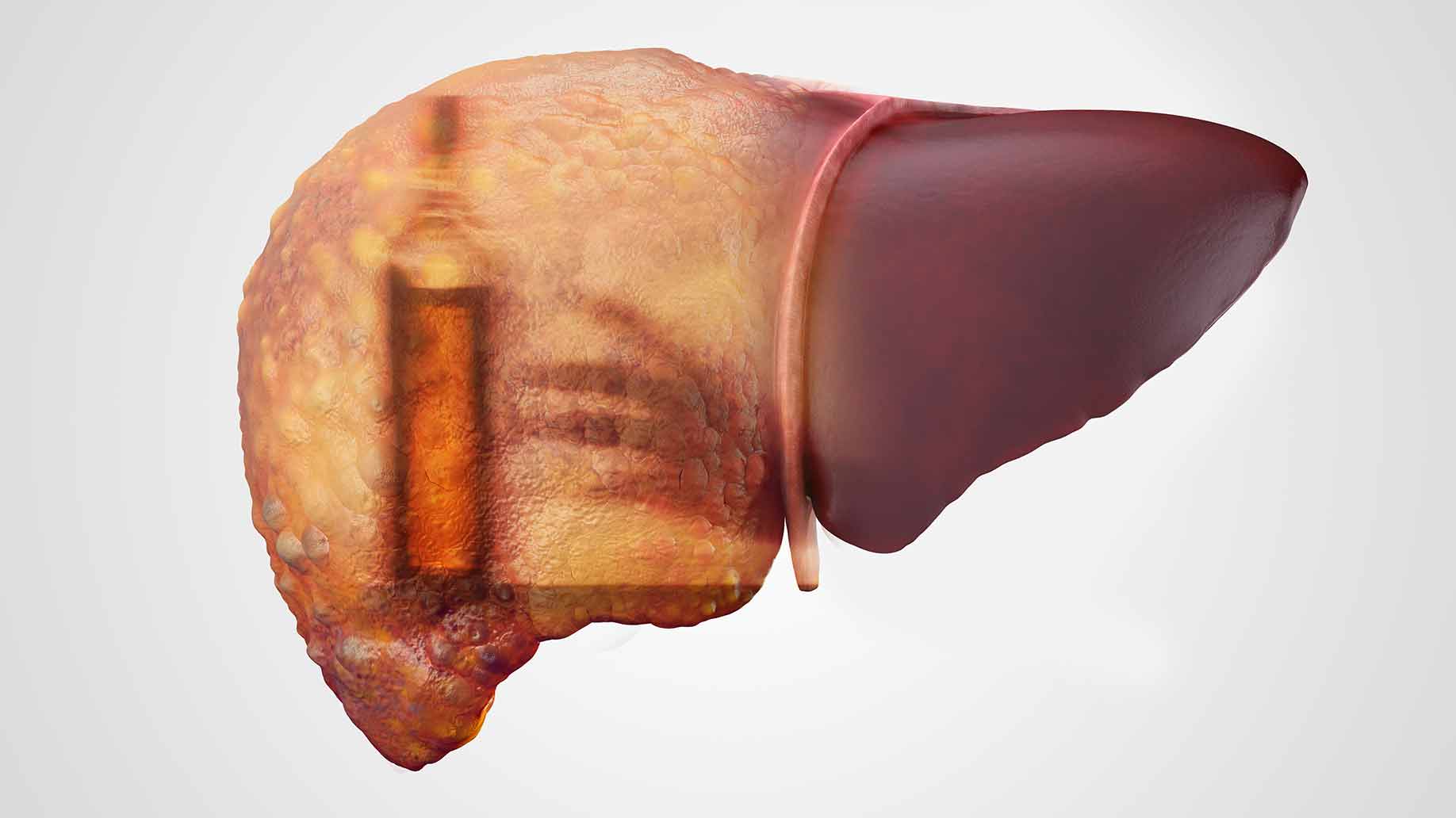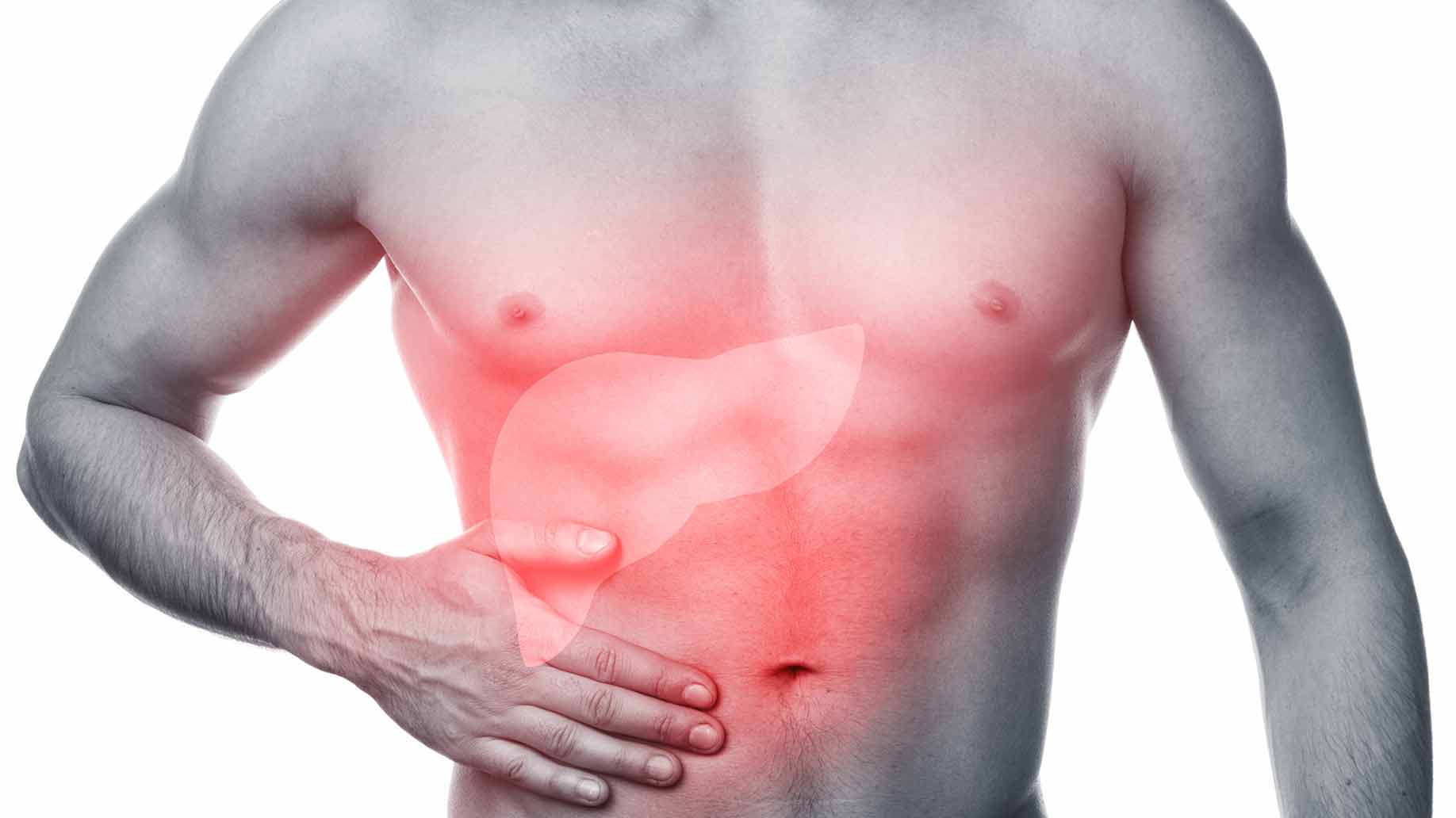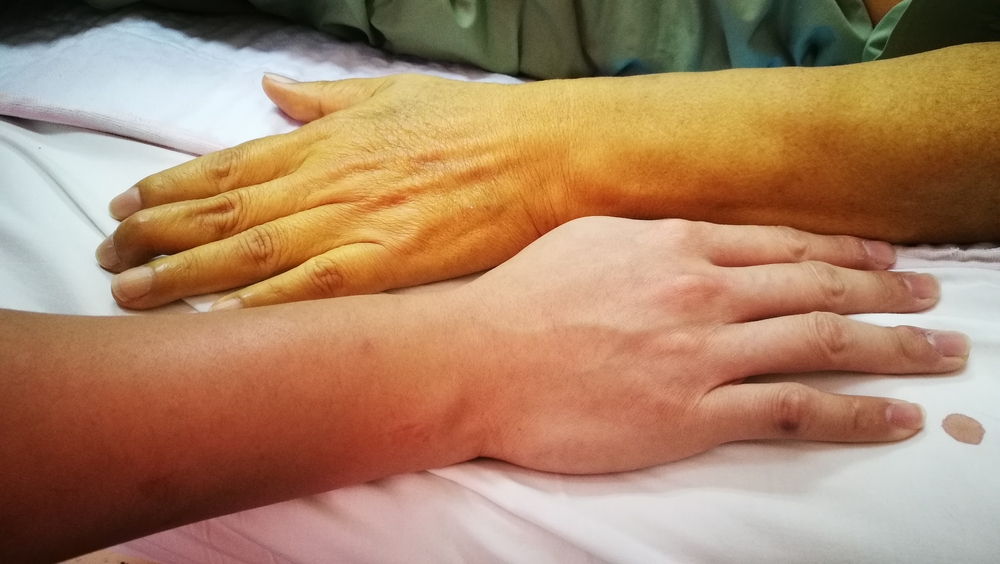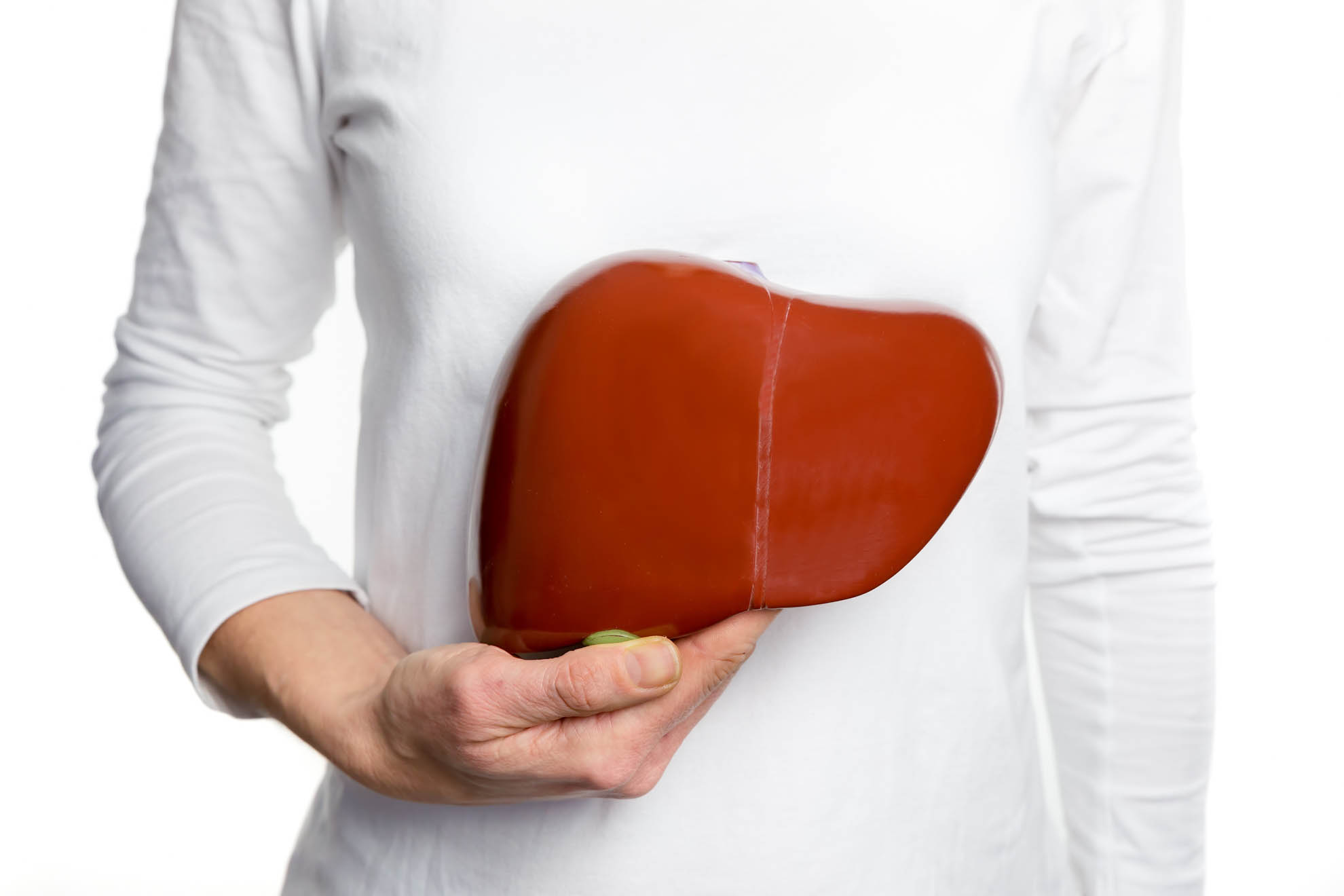The liver is an organ that acts as a filter in the purification of blood from toxins and is involved in the regulation of metabolism. A long course of inflammatory processes in an organ of various etiologies often leads to the development of destructive changes in cellular structures. As a result of these pathological changes, there are signs of cirrhosis of the liver, which, progressing, often lead to death.
Material Content:
What is liver cirrhosis
With liver cirrhosis, the organ parenchyma suffers, that is, its cellular structure is destroyed. This pathological process leads to a violation of blood flow in the vascular system of the liver and the function of bile secretion.
The progression of the disease significantly changes the anatomical structure of the organ. Fibrous tissue appears in it in the form of various sized nodes. As a result of these processes, the liver acquires tuberosity, becomes dense and loses the ability to perform its main function. As a rule, cirrhosis of the liver is a complicated variant of a long inflammatory process or a consequence of organ damage by a viral infection.
Stages of the disease, classification
With cirrhosis, structural changes in the organ develop gradually, moving from one stage to another with an increase in clinical symptoms.
Depending on the severity of the external and internal manifestations of the disease, the following stages of the process are distinguished:
- Stage 1 (compensation). The process is in the form of inflammatory-necrotic phenomena in the liver. They are detected only with laboratory or instrumental examination methods. During this period, liver tests altered in the direction of increase, changes in the structure of the liver by ultrasound are observed. External manifestations of the disease are insignificant, since healthy liver cells take on the functions of damaged structures, working in an enhanced mode. Periodic fatigue and malaise rarely lead patients to the doctor.
- Stage 2 (subcompensation). The pathological process progresses, manifesting not only internal, but also external changes. A more pronounced clinic appears, characteristic of the course of the inflammatory process, as well as a specific symptom in hepatic pathology. This is skin itching with the appearance of yellowness of the external integument and sclera of the eyes. At this stage of the disease, the damaged cellular structures of the liver are replaced by connective tissue, which grows over a significant area of the organ. The irreversible process of liver destruction continues.
- Stage 3 (decompensation). The symptomatology of the manifestation of the disease is growing. In most cases, the presence of various complications is characteristic. There is a great danger of degeneration of cirrhosis of the liver into oncology. The patient's condition at this stage of the development of the disease is characterized as severe, which often leads to death.
- Stage 4 (terminal). The patient falls into a coma. Significant changes in the blood. The liver is almost losing its function. Increasing toxic poisoning by slag provokes a malfunction in the work of all body systems. As a rule, a patient dies without leaving a coma.
The first signs of cirrhosis that arose in a patient will progress if assistance is not provided in the treatment of the disease. Therapy of the pathological process can inhibit its transition to the next stage of development.
There is no unified classification of types of liver cirrhosis, therefore, this disease is considered in several ways.
In practice, they often pay attention to etiology, highlighting the following types:
- viral - caused by hepatitis B, C, D viruses;
- alcoholic;
- autoimmune;
- cholestatic;
- hepatotoxic;
- arising from metabolic disorders of a genetic nature.
There is a clinic division. It:
- portal;
- post-necrotic;
- biliary;
- mixed.
According to the degree of compensation:
- compensated stage;
- decompensated stage.
By activity:
- inactive phase;
- active phase.
Reasons for development
The causes of cirrhosis can be very different.
The most common causes of the development of this pathology, which are diagnosed in 80% of cases, are:
- chronic alcoholism;
- viral hepatitis B, C, D.
In addition, the provoking factors in the development of the disease can be:
- pathology from the biliary tract in the form of inflammatory processes or the presence of calculi, accompanied by a violation of the outflow of bile;
- chronic intoxication with drugs or chemicals, which has a detrimental effect on the organ;
- poisons of plant origin, the result of which is acute dystrophy, accompanied by necrosis of the liver tissue;
- long-term chronic cardiovascular pathology, accompanied by venous congestion;
- violation of metabolic processes in the body of an endocrine nature, provoking fatty degeneration of the liver;
- the development of primary biliary cirrhosis without special causes in women who are in menopause;
- the occurrence of complications after gastrointestinal bypass surgery.
It is not always possible to identify one single cause of the development of the disease. Sometimes pathology is provoked by a complex of factors.
The first signs of cirrhosis in men
Male liver disease is often the result of alcohol abuse. Systematically entering alcohol into the male body hides the initial manifestations of the pathology, which are non-specific.
With liver cirrhosis, symptoms in men in the early stages of development can manifest themselves in the following clinical picture:
- reduced ability to work, malaise and fatigue;
- the appearance of increased irritability, rapid mood swings, poor sleep;
- decreased appetite and body weight;
- dyspeptic phenomena from the gastrointestinal tract;
- heaviness, pain and discomfort in the right hypochondrium;
- periodic rise in temperature to subfebrile digits.
Often men who abuse alcohol do not pay much attention to these symptoms of the initial manifestation of the disease, explaining the indisposition of withdrawal symptoms. Without therapeutic measures and against the background of continued abuse of alcoholic beverages, alcoholic cirrhosis progresses, moving to the next stage of its development.
Clinical manifestations become more pronounced and specific. The appearance of jaundice of the skin and sclera, darkening of the urine and discoloration of feces, the presence of ascites no longer raise doubts about the development of cirrhosis in men.
If alcohol abuse does not stop, the disease progresses much faster, as gross violations in the functioning of various body systems appear. As a result, the terminal stage of cirrhosis occurs, ending in a fatal outcome.
Symptoms of the disease in women
Unlike men, in women the pathological process in the liver develops much less frequently. This can be explained by the peculiarity of the female body, its hormonal background and the malfunctions that occur in the menopause. In reproductive age, frequent and prolonged use of hormonal contraceptives can have a toxic effect on the liver.
As in men, the early signs of the pathological process in women are not specific. Minor deviations in the emotional sphere and the absence of any health problems do not cause much concern. Therefore, the initial signs of liver cirrhosis are often detected by chance when examining the abdominal organs with ultrasound and in laboratory tests.
With a more careful collection of anamnesis in women, the following symptoms are noted:
- fatigue;
- irritability accompanied by sleep disturbance;
- decreased appetite;
- weight loss;
- weakness;
- bloating;
- soreness and heaviness in the epigastric region.
On palpation of the abdomen, an enlargement of the liver located along the edge of the costal arch can be detected.
If at an early stage liver cirrhosis in women is not diagnosed, the disease progresses, entering the next stage of development with already expressed clinical manifestations of pathology, which include:
- the development of hepatosplenomegaly, that is, an increase in the liver and spleen;
- the appearance of a vascular network on the body in the form of "stars" and redness on the inner surface of the palms;
- icteric coloration of the skin and sclera, which first has a periodic, and then permanent character;
- constant severity and pain in the right half of the abdomen;
- ascites or sweating of fluid into the abdominal cavity;
- expansion of the veins of the anterior abdominal wall and esophagus;
- the appearance of uterine or nosebleeds.
The course of cirrhosis can be long, and active treatment supports the stage of compensation, restraining the further development of the disease. But if a woman begins to appear edema, ascites develops, temperature rises or bleeding is noted, this is a poor prognostic symptom indicating that the disease is progressing.
Important! The appearance of minor deviations in the form of increased fatigue, periodic pain in the right hypochondrium, especially after eating fatty or fried foods, requires a mandatory examination to exclude the development of cirrhosis.
Diagnostics
The diagnosis of cirrhosis, especially in the early stages of its development, plays a very important role. The leading value in the diagnosis of the disease belongs to objective, laboratory and instrumental methods of research.
The collection of anamnesis and objective data make it possible to find out the time of the appearance of health complaints, to evaluate the size and density of the liver during palpation, the presence of vascular "stars", edema and ascites.
The diagnosis is confirmed by the following studies:
- blood for a general analysis;
- feces and urine for a general analysis;
- blood chemistry;
- blood for prothrombin;
- Ultrasound of the liver;
- dopplerometry of the vessels of the liver;
- liver biopsy;
- MRI
A full examination, especially with early diagnosis of the disease, will determine the stage of the disease and prescribe a good treatment.
Treatment and prevention of cirrhosis
Radical agents that could stop the anatomical destruction of the cellular structure of the liver do not exist. Therapy of the pathological process includes symptomatic treatment depending on the stage of the disease and the severity of the clinical manifestations.
It is designed to slow down the further development of the disease and stop the negative symptoms.
With cirrhosis of the liver of viral etiology, the following drugs are indicated:
- Interferon-alpha (only for viral cirrhosis C and D in the compensation phase);
- Baraclude
- metabolic drugs;
- Ursodeoxycholic acid - if there are contraindications for antiviral therapy (UDCA gives a positive anti-inflammatory, membrane-stabilizing effect).
Additionally shown:
- symptomatic treatment to stop the intoxication of the body;
- limitation of physical activity;
- dieting.
Corrections in the prescription of drugs are made by the doctor, depending on the cause of the development of cirrhosis, as well as the stage of development of the pathology. Implementation of all the recommendations of a specialist will improve the functioning of the liver and relieve symptoms of intoxication.
The development of such a serious disease that causes great health problems requires careful attention to both men and women to their bodies. Since the cause of the development of cirrhosis in the vast majority are viruses and alcohol intoxication, prevention should be aimed at eliminating these provoking factors.
If there is a chronic liver disease, its timely treatment and medical supervision of a specialist is mandatory.
Life expectancy with disease
Life expectancy in cirrhosis depends on many factors. Since the destruction of the liver with this disease is irreversible, early diagnosis and high-quality treatment in compliance with a strict diet can slow down the process for a long time. At the same time, the prognosis for life becomes relatively favorable.
Of great importance is the stage of development of the disease and the individual characteristics of the patient's body. In women, the negative process due to chronic alcoholism is more malignant in comparison with men, giving a higher mortality rate.
The varying severity of the process implies the following life expectancy:
- compensation stage - more than 7 years;
- subcompensation - about 5 years;
- decompensation - only 10-40% of patients survive to 3 years.
Often patients die from complications of the disease. The most formidable consequence and giving up to 40% mortality are bleeding from the dilated veins of the esophagus and gastrointestinal tract.
Only 25% of patients with ascites live for about 3 years. Most patients die before this time.Patients with hepatic encephalopathy live even less. They die within a year.
In any case, the prognosis for life with cirrhosis is poor.
Prevention
To avoid the development of severe progressive liver pathology, the following prevention rules must be observed:
- regular prophylactic examinations with an examination of ultrasound of the abdominal cavity;
- restriction in the use of alcoholic beverages;
- timely and high-quality treatment of diseases of the liver and biliary tract;
- in the presence of viral hepatitis, the conduct of mandatory courses of treatment with confirmation by a laboratory analysis of positive dynamics;
- dispensary observation with systematic monitoring of the doctor over the state of the liver;
- optimal physical activity;
- proper balanced nutrition.
Following these simple rules of prevention will help prevent the development of a disease that has a poor prognosis for life.






























